Logic Supply Core-ML320 Fanless Industrial NUC Review
by Ganesh T S on April 30, 2014 3:45 PM EST- Posted in
- NUC
- Industrial PC
- Passive Cooling
- Logic Supply
Performance Metrics - II
In this section, we mainly look at benchmark modes in programs used on a day-to-day basis, i.e, application performance and not synthetic workloads.
x264 Benchmark
First off, we have some video encoding benchmarks courtesy of x264 HD Benchmark v5.0.
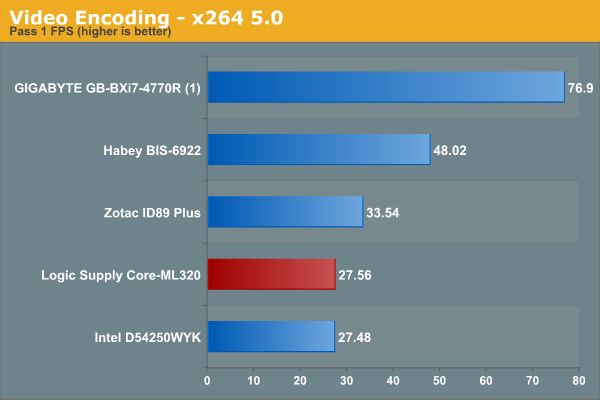

7-Zip
7-Zip is a very effective and efficient compression program, often beating out OpenCL accelerated commercial programs in benchmarks even while using just the CPU power. 7-Zip has a benchmarking program that provides tons of details regarding the underlying CPU's efficiency. In this subsection, we are interested in the compression and decompression MIPS ratings when utilizing all the available threads
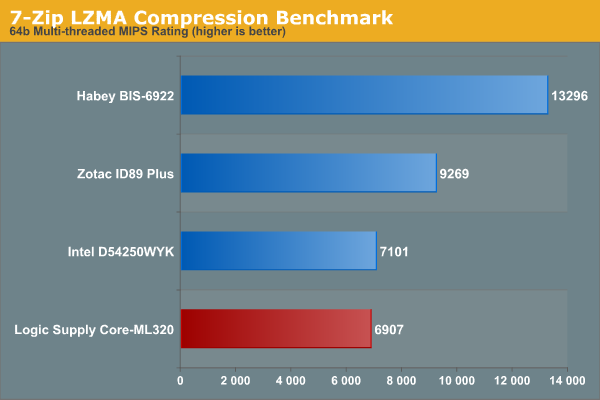
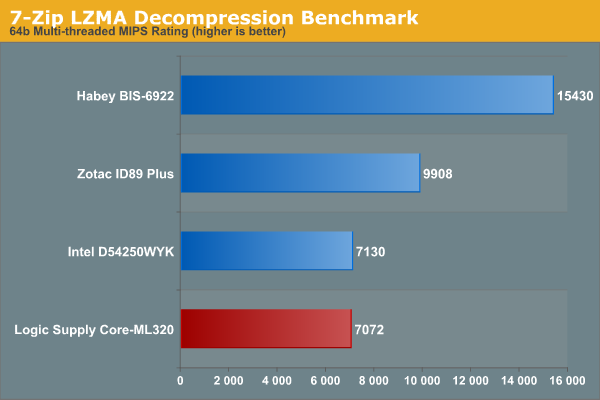
TrueCrypt
As businesses (and even home consumers) become more security conscious, the importance of encryption can't be overstated. CPUs supporting the AES-NI instruction for accelerating the encryption and decryption processes have, till now, been the higher end SKUs. However, with Bay Trail, even the lowly Atom series has gained support for AES-NI. The i5-4250U in the Core-ML320 has AES-NI support. TrueCrypt is a popular open-source disk encryption program which can take advantage of the AES-NI capabilities. The TrueCrypt internal benchmark provides some interesting cryptography-related numbers to ponder. In the graph below, we can get an idea of how fast a TrueCrypt volume would behave in the Core-ML320 and how it would compare with other select PCs.
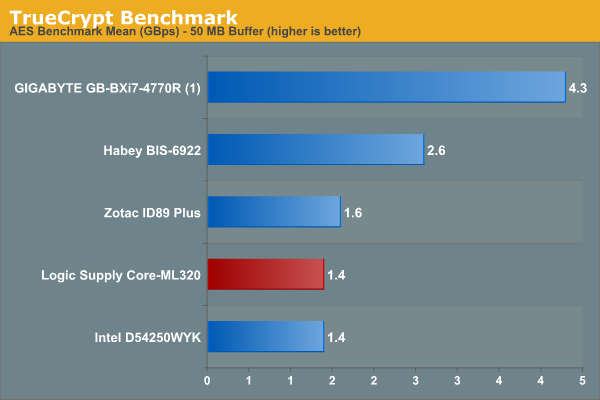
Agisoft Photoscan
Agisoft PhotoScan is a commercial program that converts 2D images into 3D point maps, meshes and textures. The program designers sent us a command line version in order to evaluate the efficiency of various systems that go under our review scanner. The command line version has two benchmark modes, one using the CPU and the other using both the CPU and GPU (via OpenCL). The benchmark takes around 50 photographs and does four stages of computation:
- Stage 1: Align Photographs
- Stage 2: Build Point Cloud (capable of OpenCL acceleration)
- Stage 3: Build Mesh
- Stage 4: Build Textures
We record the time taken for each stage. Since various elements of the software are single threaded, others multithreaded, and some use GPUs, it is interesting to record the effects of CPU generations, speeds, number of cores, DRAM parameters and the GPU using this software.
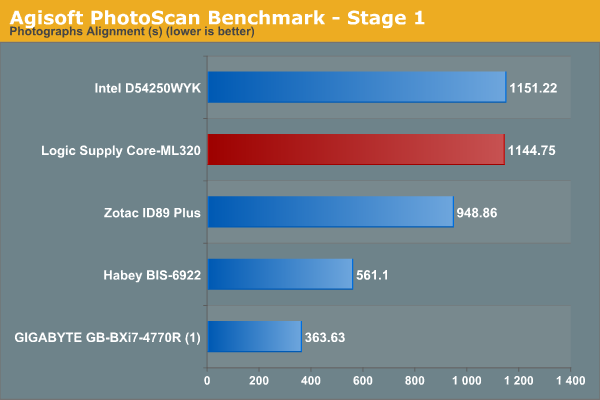
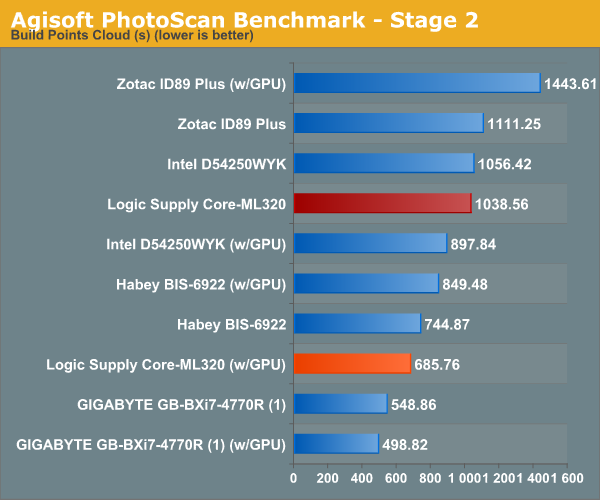
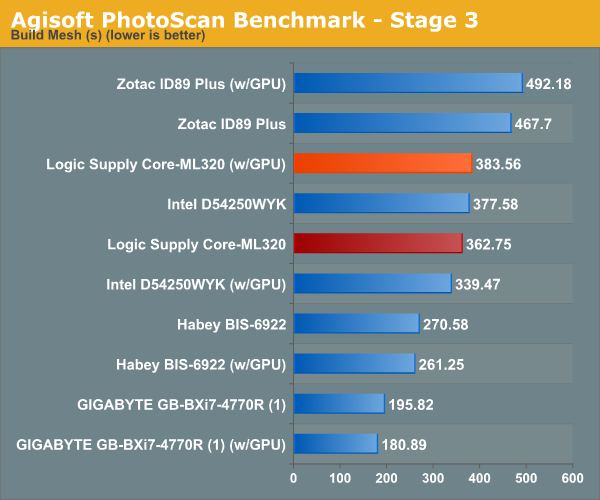
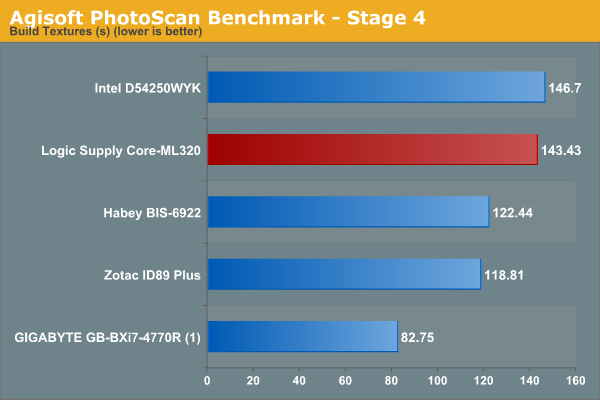
Dolphin Emulator
Wrapping up our application benchmark numbers is the Dolphin Emulator benchmark mode results.
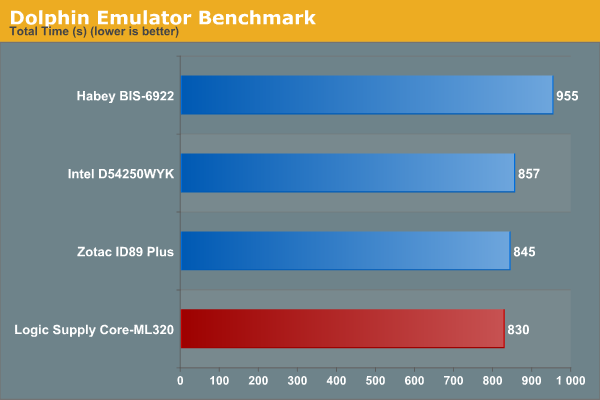










31 Comments
View All Comments
jcknows0 - Wednesday, April 30, 2014 - link
The chassis itself is a little on the pricey side. Its pretty hard to recommend a $1300 i5 system with less than 100 GB SSD space. I just built my latest NUC for under $300, just doesn't seem worth it for fanless.faiakes - Wednesday, April 30, 2014 - link
For Europeans, there is the very similar Alaska Tesla H. High-tech reviewed it and compared it to the Intel and another custom case herehttp://www.bit-tech.net/hardware/cases/2014/03/20/...WithoutWeakness - Wednesday, April 30, 2014 - link
The target market for these types of fanless, industrial, SFF machines is not the same target market as Intel's off-the-shelf NUC or Gigabyte's Brix. Fanless boxes like these are meant to be deployed in areas where the machine likely needs to be running 24/7/365 and any downtime is an order of magnitude more costly than the $1300 that the box costs. Overheating due to fan failures, untimely deaths of non-enterprise-grade SSD's (or, god forbid, platter-based hard drives), and other potential issues can be avoided by getting something like this box that is built specifically for the application. For other uses a NUC makes more sense (I bought a NUC to run as a cheap all-purpose media/backup/Mumble server and I love it) but for industrial and enterprise purposes you're far better off getting something like this.BryanC - Wednesday, April 30, 2014 - link
Why is it acceptable for a fanless industrial SFF machine like this to have an external power supply? Seems like that significantly complicates installation, especially in tight, cramped areas where this type of machine is attractive. Also, I'd be worried about the reliability of the power supply, it doesn't look like it's engineered to last.WithoutWeakness - Wednesday, April 30, 2014 - link
Not a clue. I definitely have to agree that an internal power supply would make the unit far easier to install because you wouldn't have to find a spot to put the brick. My best guess would be that it would make the unit larger and run hotter as the PSU would be unable to vent externally. Apple's Mac Mini is only slightly larger than this and has an internal PSU and 35W CPU but it also has a fan to help keep thermals in check.Mac Mini: 7.7" wide, 7.7" deep, 1.4" tall
Core-ML320: 7.72" wide, 5.17" deep, 1.45" tall
DanNeely - Wednesday, April 30, 2014 - link
Probably because of the optional 6-30VDC input jack. That's flexible enough that you should be able to wire it into the existing power system of whatever machine it's embedded in.evilspoons - Thursday, May 1, 2014 - link
This is exactly the reason. Every industrial panel I've ever installed a PC in already has a 24 VDC power supply for the rest of the control system.BryanC - Thursday, May 1, 2014 - link
Thanks, I learned something today! =)BedfordTim - Saturday, May 3, 2014 - link
I couldn't find the 6-30VDC input jack option on the website, but the NUC motherboard itself does have a 12-24V input. The motherboard manual is inconsistent about input voltages, and Intel haven't been very helpful in clarifying this.Lothsahn - Thursday, May 1, 2014 - link
One reason is that with the industrial market, they'll actually have a DC line they want to wire the devices into.